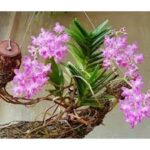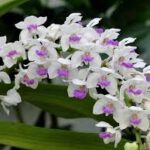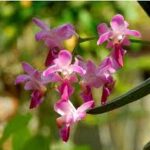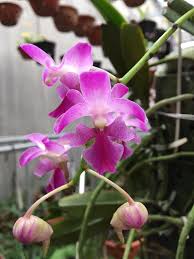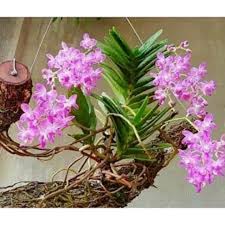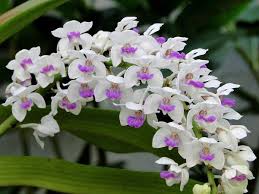
**Introduction to Sato Cymbidium Orchids**
Sato Cymbidium orchids are prized for their exquisite beauty, diverse colors, and delicate fragrances. Native to various regions, including Southeast Asia, these orchids have captured the hearts of gardeners and flower enthusiasts worldwide. However, successful cultivation requires understanding the specific needs of these plants, particularly regarding humidity levels. This article explores how humidity impacts the growth of Sato Cymbidium orchids, highlighting its importance in overall health, blooming, and care practices.
**Understanding Humidity in the Orchid’s Natural Habitat**
Humidity refers to the amount of moisture in the air, typically expressed as a percentage. In their natural habitat, Sato Cymbidium orchids thrive in environments with high humidity, often ranging from 50% to 80%. These humidity levels are common in tropical and subtropical regions where these orchids grow among trees and in moist, shaded areas. Understanding the natural humidity levels of Sato Cymbidium orchids is crucial for replicating their growing conditions in domestic settings.
**The Importance of Humidity for Orchids**
1. **Water Absorption and Transpiration**
Humidity plays a vital role in the water absorption process of Sato Cymbidium orchids. These plants absorb moisture not only through their roots but also through their leaves and pseudobulbs. When humidity levels are high, the rate of transpiration—the process by which water vapor is released from plant surfaces—is regulated. Adequate humidity levels help maintain moisture balance, reducing the risk of dehydration and stress on the plant.
2. **Nutrient Uptake**
Optimal humidity conditions facilitate the uptake of essential nutrients from the growing medium. When humidity is at appropriate levels, Sato Cymbidium orchids can effectively absorb water and dissolved nutrients, promoting healthy growth and vibrant blooms. Low humidity may lead to nutrient deficiencies, stunted growth, and poor flowering.
3. **Root Health**
The health of the root system is critical to the overall well-being of Sato Cymbidium orchids. High humidity levels support root development by maintaining a moist environment that encourages root growth. Conversely, low humidity can lead to dry, brittle roots, which may inhibit nutrient absorption and increase the risk of root rot when combined with overwatering.
**Effects of Low Humidity on Sato Cymbidium Orchids**
1. **Dehydration and Stress**
One of the most significant impacts of low humidity is the risk of dehydration. When humidity levels fall below the optimal range, Sato Cymbidium orchids may struggle to retain moisture. This can lead to wilting leaves, shriveled pseudobulbs, and overall stress on the plant. Prolonged periods of low humidity can ultimately result in weakened plants, making them more susceptible to diseases and pests.
2. **Leaf Damage**
Insufficient humidity can cause leaf curling and browning, particularly at the tips and edges. This condition, often referred to as leaf scorch, is a sign that the plant is experiencing water loss and may not be able to recover if humidity levels do not improve. Additionally, low humidity can lead to the development of brown spots on leaves, further compromising the plant’s aesthetic appeal.
3. **Poor Flowering**
Low humidity levels can adversely affect the blooming process of Sato Cymbidium orchids. When these plants are deprived of adequate moisture, they may produce fewer flowers, and those that do bloom may be smaller and less vibrant. Moreover, the overall flowering period may be shortened, reducing the plant’s overall attractiveness.
**Effects of High Humidity on Sato Cymbidium Orchids**
1. **Promoting Healthy Growth**
High humidity is generally beneficial for Sato Cymbidium orchids, as it promotes healthy growth and robust foliage. Adequate moisture levels encourage the development of lush, green leaves and strong pseudobulbs, which are essential for storing nutrients and water. As a result, these plants can thrive and produce stunning blooms when provided with optimal humidity levels.
2. **Enhancing Flower Quality**
In addition to supporting vegetative growth, high humidity levels can enhance the quality of flowers produced by Sato Cymbidium orchids. When humidity is sufficient, the flowers tend to be larger, more vibrant, and exhibit richer colors. High humidity also aids in the retention of fragrance, which can be a significant factor for orchid enthusiasts seeking aromatic varieties.
3. **Preventing Stress**
Maintaining a consistently humid environment can help prevent stress-related issues in Sato Cymbidium orchids. When humidity levels remain within the optimal range, plants are less likely to experience sudden fluctuations in moisture, reducing the risk of dehydration and other stress factors. This stability contributes to the overall health and longevity of the orchids.
**Creating Optimal Humidity Conditions**
To cultivate healthy Sato Cymbidium orchids, growers must create and maintain optimal humidity conditions. Here are some effective strategies to achieve the desired humidity levels:
1. **Using Humidifiers**
One of the most effective methods for increasing humidity is to use a humidifier. Placing a humidifier in the vicinity of the orchids can help maintain consistent moisture levels, especially in drier indoor environments. It is essential to monitor the humidity levels regularly to ensure they remain within the ideal range for Sato Cymbidium orchids.
2. **Grouping Plants Together**
Grouping Sato Cymbidium orchids with other humidity-loving plants can create a microclimate that retains moisture. As plants transpire, they release water vapor into the air, increasing humidity levels in the immediate vicinity. This natural method can be particularly effective in maintaining optimal humidity without the need for additional equipment.
3. **Misting and Water Trays**
Misting the leaves of Sato Cymbidium orchids can temporarily boost humidity levels, especially during dry periods. However, misting should be done in moderation to avoid excess moisture buildup on the leaves, which can lead to fungal infections. Additionally, placing a shallow tray filled with water and pebbles under the orchids can create a humid microenvironment without direct contact with the roots.
4. **Proper Potting Media**
The choice of potting media can influence humidity retention. Using a well-draining mix that retains some moisture while allowing for airflow can help maintain a suitable humidity level. Orchid bark, sphagnum moss, and perlite are popular components of potting media that can contribute to a healthy growing environment.
**5. Monitoring Environmental Factors**
Maintaining optimal humidity levels requires continuous monitoring of environmental factors. Growers should invest in a hygrometer to measure humidity accurately. Regularly checking humidity levels allows for timely adjustments to the growing environment, ensuring that Sato Cymbidium orchids receive the care they need to thrive.
**Conclusion**
In conclusion, humidity plays a crucial role in the growth and development of Sato Cymbidium orchids. Understanding the impact of humidity on these beautiful plants is essential for successful cultivation. High humidity levels promote healthy growth, vibrant blooms, and overall plant well-being, while low humidity can lead to dehydration, stress, and poor flowering. By creating optimal humidity conditions through various strategies, growers can enhance the beauty and longevity of their Sato Cymbidium orchids, allowing them to flourish in both indoor and outdoor settings. In the next part, we will delve deeper into the specific techniques for maintaining humidity levels and their effects on the growth of these exquisite orchids.
### The Impact of Humidity on the Growth of Sato Cymbidium Orchids (Part 2)
**Maintaining Optimal Humidity Levels**
In the first part of this article, we explored the importance of humidity for Sato Cymbidium orchids and its effects on their growth, health, and blooming potential. In this section, we will delve deeper into practical methods and techniques for maintaining optimal humidity levels, assessing the relationship between humidity and various aspects of orchid care, and discussing the effects of different humidity conditions on Sato Cymbidium orchids.
#### Techniques for Maintaining Humidity
1. **Understanding Ideal Humidity Levels**
To create the perfect environment for Sato Cymbidium orchids, it is essential to understand their preferred humidity range. As mentioned earlier, these orchids thrive in humidity levels between 50% and 80%. Maintaining humidity within this range can help promote robust growth, vibrant flowers, and overall plant health.
2. **Utilizing Humidifiers**
Humidifiers are one of the most effective tools for maintaining optimal humidity levels, particularly in dry indoor environments. There are various types of humidifiers available, including ultrasonic, evaporative, and steam vaporizers. Ultrasonic humidifiers are particularly popular for their ability to produce a fine mist without heating the water, ensuring that the humidity levels rise without altering the temperature of the environment.
– **Placement and Maintenance:** When using a humidifier, it is important to place it near the orchids but not directly on them to prevent water accumulation on leaves, which can lead to fungal issues. Regular cleaning of the humidifier is also crucial to avoid mold and bacteria growth, which can negatively affect the health of the orchids.
3. **Creating Microclimates**
Grouping Sato Cymbidium orchids together can create a microclimate that retains humidity. As plants transpire, they release moisture into the air, increasing the local humidity around them. This natural method not only helps maintain humidity levels but also provides an aesthetically pleasing display.
– **Choosing Companion Plants:** When grouping orchids, choose plants that share similar humidity and light requirements. Ferns, peace lilies, and certain tropical plants can make excellent companions for Sato Cymbidium orchids, enhancing both humidity and visual appeal.
4. **Using Water Trays and Pebbles**
One effective and low-tech method for increasing humidity is to place shallow trays filled with water and pebbles underneath the orchids. As the water evaporates, it raises the humidity level around the plants.
– **How to Set Up Water Trays:** Ensure that the pots of the orchids are above the water level, resting on the pebbles. This setup prevents water from sitting directly on the roots, which could cause root rot. Additionally, replacing the water regularly will help maintain a clean environment.
5. **Misting Techniques**
Misting is a quick and straightforward way to temporarily increase humidity around orchids, particularly during hot or dry weather. Using a spray bottle, mist the leaves of the Sato Cymbidium orchids to create a humid atmosphere. However, this technique should be used judiciously.
– **Timing and Frequency:** Misting should be done in the morning to allow the moisture to evaporate throughout the day, preventing the leaves from staying wet overnight, which could promote fungal diseases. Mist only when necessary, as excessive moisture can lead to issues.
6. **Incorporating Sphagnum Moss**
Using sphagnum moss as part of the potting medium can help retain moisture around the roots while providing aeration. This organic material naturally absorbs water and releases it slowly, contributing to a stable humidity level.
– **Potting Mix Recommendations:** When potting Sato Cymbidium orchids, consider mixing sphagnum moss with bark chips and perlite for a well-draining yet moisture-retentive medium. This combination helps support humidity while ensuring that the roots are not waterlogged.
#### Assessing Humidity Levels
1. **Utilizing Hygrometers**
Investing in a hygrometer is essential for accurately measuring humidity levels in the orchid’s environment. These devices can provide real-time readings, allowing growers to monitor changes and adjust conditions accordingly.
– **Digital vs. Analog Hygrometers:** Digital hygrometers are generally more accurate and easier to read than analog models. Some digital options come with temperature displays and alarms that notify the user when humidity levels fall outside the desired range.
2. **Adjusting Environmental Factors**
Humidity levels can be influenced by other environmental factors such as temperature and airflow. For example, heating systems or air conditioning can lower humidity levels, especially in closed spaces.
– **Creating a Balanced Environment:** To maintain ideal humidity levels, consider adjusting the temperature settings to promote optimal conditions. Additionally, ensuring good air circulation can help maintain a stable humidity environment while preventing stagnant air, which may lead to fungal issues.
#### The Relationship Between Humidity and Orchid Care
1. **Fertilization Practices**
Humidity influences nutrient uptake in Sato Cymbidium orchids, making fertilization practices critical. High humidity can enhance the absorption of liquid fertilizers, but it’s essential to apply them correctly to avoid over-fertilization.
– **When to Fertilize:** Fertilize during the growing season when the orchids are actively developing. During the dormant period, reduce or eliminate fertilizer applications, as the plant’s nutrient requirements will decrease.
2. **Watering Regimen**
The watering regimen is closely tied to humidity levels. In high humidity conditions, orchids may require less frequent watering, as the moisture in the air helps sustain the plant’s hydration. Conversely, in low humidity, more frequent watering may be necessary to prevent dehydration.
– **Checking Moisture Levels:** Always check the moisture level of the potting medium before watering. A moisture meter can be beneficial for ensuring that the orchids are adequately hydrated without risking overwatering.
3. **Pest and Disease Management**
Humidity plays a significant role in the susceptibility of Sato Cymbidium orchids to pests and diseases. High humidity levels can create an environment conducive to fungal infections, while low humidity may lead to increased vulnerability to pests such as spider mites.
– **Preventative Measures:** To minimize disease risk, ensure good air circulation around the orchids. Regularly inspect plants for any signs of pests or diseases, and take immediate action if any issues are detected.
4. **Pruning and Maintenance**
Regular maintenance, including pruning and deadheading, is essential for the health of Sato Cymbidium orchids. High humidity can encourage vigorous growth, necessitating periodic pruning to promote airflow and prevent overcrowding.
– **Best Practices for Pruning:** Use sterile tools when pruning to prevent the spread of disease. Remove any dead or yellowing leaves, and cut back any leggy growth to encourage bushier plant development.
#### Effects of Varying Humidity Conditions
1. **Low Humidity Conditions**
As previously discussed, low humidity can lead to various negative effects on Sato Cymbidium orchids, including dehydration, poor flowering, and leaf damage. However, understanding how to mitigate these effects can significantly improve the orchids’ chances of thriving in less-than-ideal conditions.
– **Resilience Strategies:** If faced with low humidity, increase watering frequency and consider using a humidifier or water trays. Keep the orchids in a more humid area of the home, such as a bathroom or kitchen, where moisture levels may be higher.
2. **High Humidity Conditions**
While high humidity generally benefits Sato Cymbidium orchids, excessive moisture can also pose challenges. Prolonged exposure to very high humidity without proper air circulation can lead to fungal infections and rot.
– **Managing Excess Humidity:** Ensure proper ventilation around the orchids, and consider using fans or opening windows to promote airflow. Additionally, avoid letting water accumulate in the pots, as this can lead to root rot.
3. **Adapting to Seasonal Changes**
Humidity levels can fluctuate seasonally, which may affect how Sato Cymbidium orchids are cared for. For instance, indoor heating during winter months often leads to drier air, while summer humidity can rise significantly.
– **Seasonal Adjustments:** Be prepared to adjust your humidity management strategies as the seasons change. For example, use humidifiers during winter and consider increasing misting frequency during the summer months when temperatures rise.
#### Conclusion
The impact of humidity on the growth of Sato Cymbidium orchids cannot be overstated. Proper humidity levels are essential for maintaining plant health, promoting robust growth, and ensuring vibrant blooms. By employing effective humidity management techniques, regularly monitoring conditions, and understanding the relationship between humidity and orchid care, growers can create an optimal environment for these stunning flowers.
As we have explored in both parts of this article, understanding and managing humidity is a key aspect of successful Sato Cymbidium orchid cultivation. By providing these orchids with the humidity levels they crave, orchid enthusiasts can enjoy the beauty and elegance of Sato Cymbidium orchids in their homes, allowing these remarkable plants to flourish.

